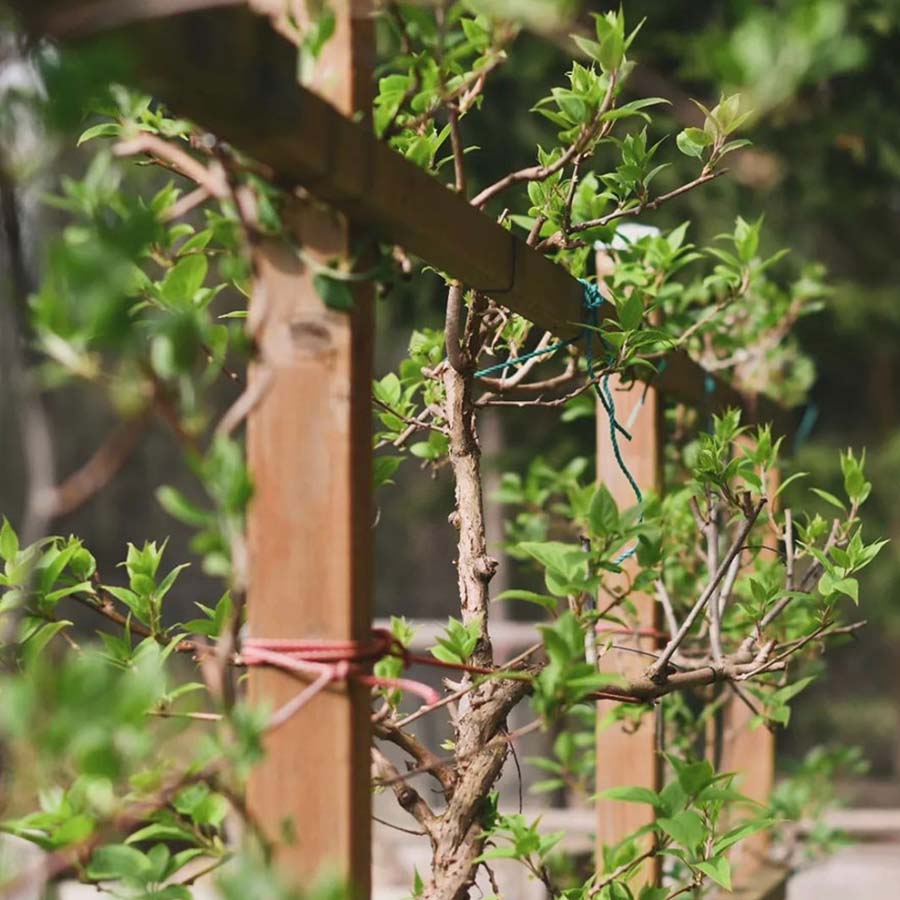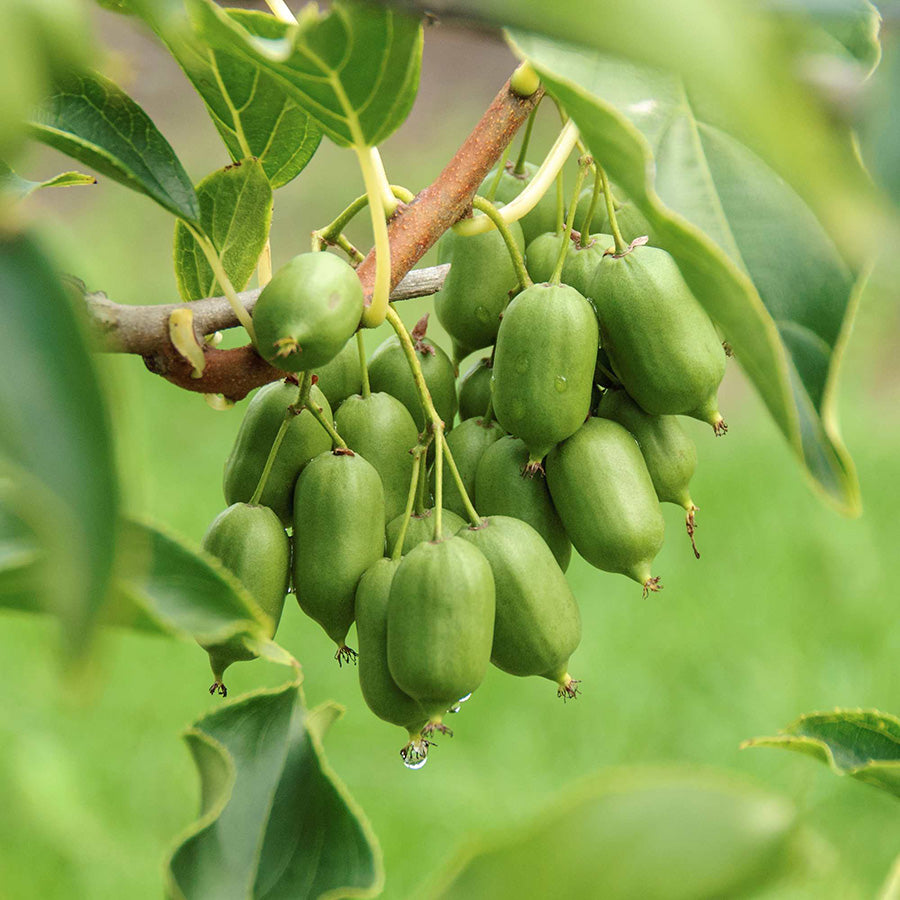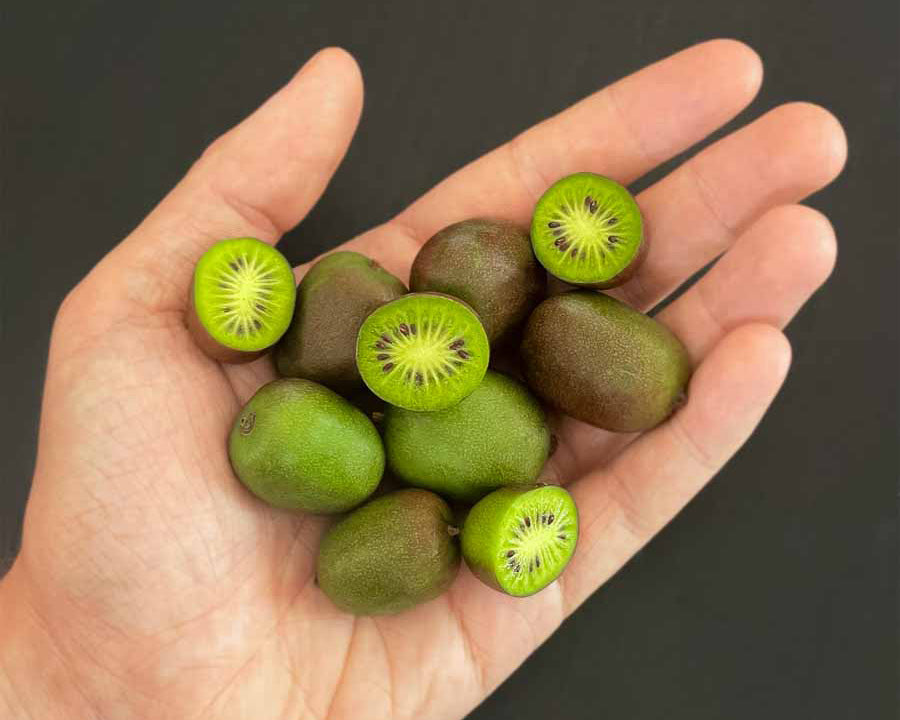
Growing kiwi berries
Step-by-step instructions for growing kiwi berries - with Kiwiri's knowledge from over 40 years of cultivation, breeding and processing.
Table of contents

Actinidia arguta
Kiwi berries
The kiwiberry (Actinidia arguta), also called the miniature kiwi, is a species of plant in the Actinidia family and is closely related to tropical kiwis (Actinidia deliciosa). They originate from North Asia, where they grow up trees as forest companion plants.
Since they are hardy to -25°C and very easy to care for, they are ideal for growing in home gardens and on balconies.

SUPERFOOD
Vitamin booster
Hard to believe given their sweet aroma, but kiwi berries contain more vitamin C than lemons for the same amount.
They are also rich in antioxidants and fiber, making them a great addition to a healthy diet.
Variety selection
Button label-

aroma
Kiwi berries have a tropically sweet taste with a slight acidity. Our varieties differ only in nuances. The later a kiwi berry ripens, the sweeter it tastes. More important are aspects such as ripening time and appearance.
-

ripening time
To the kiwi berry rangeKiwi berries are harvested in the fall. We distinguish between early (September), mid (early October), and late (late October) ripening periods. By combining different varieties, you can achieve a long harvest period.
-

pollination
Show male kiwiberryFemale kiwiberry blossoms are pollinated by a male pollinator in May to produce fruit. One pollinator can pollinate up to six female plants within a 25-meter radius.
-

Myth of self-fertility
Conditionally self-fertile varietiesConditionally self-fertile kiwi berries are actually female and can only produce a few small fruits without pollination. They have no pollen and therefore cannot fertilize other plants.

Variety overview
Our variety overview provides an insight into the diversity of kiwi berries. Our varieties are sorted by ripening time, fruit color, pollination, and origin.
Location
-

Sun
To ensure the fruit ripens perfectly, kiwi berries require a partially shaded to sunny location. East-, west-, and south-facing locations are suitable.
-

Earth
planting instructionsKiwi plants have shallow roots and adapt to all soil types. They prefer acidic soil that retains water well. We recommend rhododendron soil for planting.
-

Trellis
Kiwiri RANKI - Trellis for climbing plantsAs climbing plants, all kiwi plants require a support such as a garden fence, trellis, pergola or an old tree.
video
Care
All video tutorials-

Summer cut
Video instructions for summer pruningSummer pruning takes place in July/August. Fruit shoots are shortened after the last fruit, and the leaf mass is reduced. This allows the plant to focus all its energy on fruit development.
-

Winter pruning
Video instructions for winter pruningIn December/January, thin out your kiwi berries. Remove unnecessary shoots, and cut back fruiting wood to 3-4 leaf axils.
-

irrigation and fertilization
Kiwi fertilizerThe root system of kiwi plants should never dry out completely. In sunny locations, a layer of mulch can help. Fertilization promotes healthy growth and strong flowering.
harvest
Button label-

harvest
Video instructions for harvestingFrom the second to third year onwards, our kiwi berries produce annual fruits. These are harvested in the fall as individual fruits or as clusters with fruit branches.
-

storage
Video instructions for freezingMini kiwis will keep for several weeks refrigerated, and even several months frozen. Before freezing, wash them thoroughly and remove the small stems.
-

processing
Discover our foodKiwi berries, fresh or stored in a cool place, can be used to make jams, chutneys, desserts, juices and tropically sweet smoothies, among other things.
video
Frequently Asked Questions
Are kiwi berries hardy?
Kiwi berries are winter-hardy down to -25 degrees Celsius. They are extremely robust shrubs that originate from cold regions of Asia. They were also bred and selected specifically for our latitudes.
Tip: If your kiwi berries have already sprouted in spring and there is a risk of late frost again, you can cover them with fleece for this limited time or place them in a greenhouse to protect the new shoots from frost.
When is the best time to plant?
Kiwi plants can be planted in the ground year-round, as long as the ground is not frozen. In spring, we recommend planting after the Ice Saints, when late frosts have passed. You can order kiwi berries from us year-round and, if necessary, overwinter them in a protected outdoor location (e.g., in an open greenhouse, house wall, or carport) until planting.
Which kiwi berry variety is the best?
All of our available kiwi berries (Act. arguta) have been tested for decades, are very robust, and super delicious. They differ only in nuances in taste. The most important distinguishing features are therefore ripening time and fruit color.
Do I need a male kiwiberry?
Kiwi berries are dioecious. Therefore, they require a male kiwi berry (Actinidia arguta) for pollination. This male kiwi berry (Actinidia arguta) can pollinate up to six female kiwi berries (Actinidia arguta) within a 25-meter radius.
Conditionally self-fertile varieties can produce some small fruits without pollinators, but are purely female and have no pollen.
How much space do kiwi plants need?
Because kiwi berries have shallow roots, we recommend planting one to two meters apart. The height and width are determined by the trellis. Kiwi berries won't grow beyond this distance.
How often do you water kiwi berries?
The root system of kiwi plants should never dry out completely. In sunny locations, a layer of mulch can help. In midsummer, kiwi berries need about 2 liters of water per day.
Why isn't my kiwi plant bearing fruit?
In most cases, a pollinator variety is missing or the plants are male. Our nursery team will help you identify your plants and recommend suitable varieties.
At Kiwiri, you receive a variety guarantee to ensure your harvest success.
Can you grow kiwi berries in pots?
Kiwi berries can be grown in pots on balconies and terraces. These should have a volume of at least 40 liters to prevent the soil from freezing in winter.

Kiwiri Team
Still questions?
Our kiwi nursery team will answer all your questions about kiwi berries.













